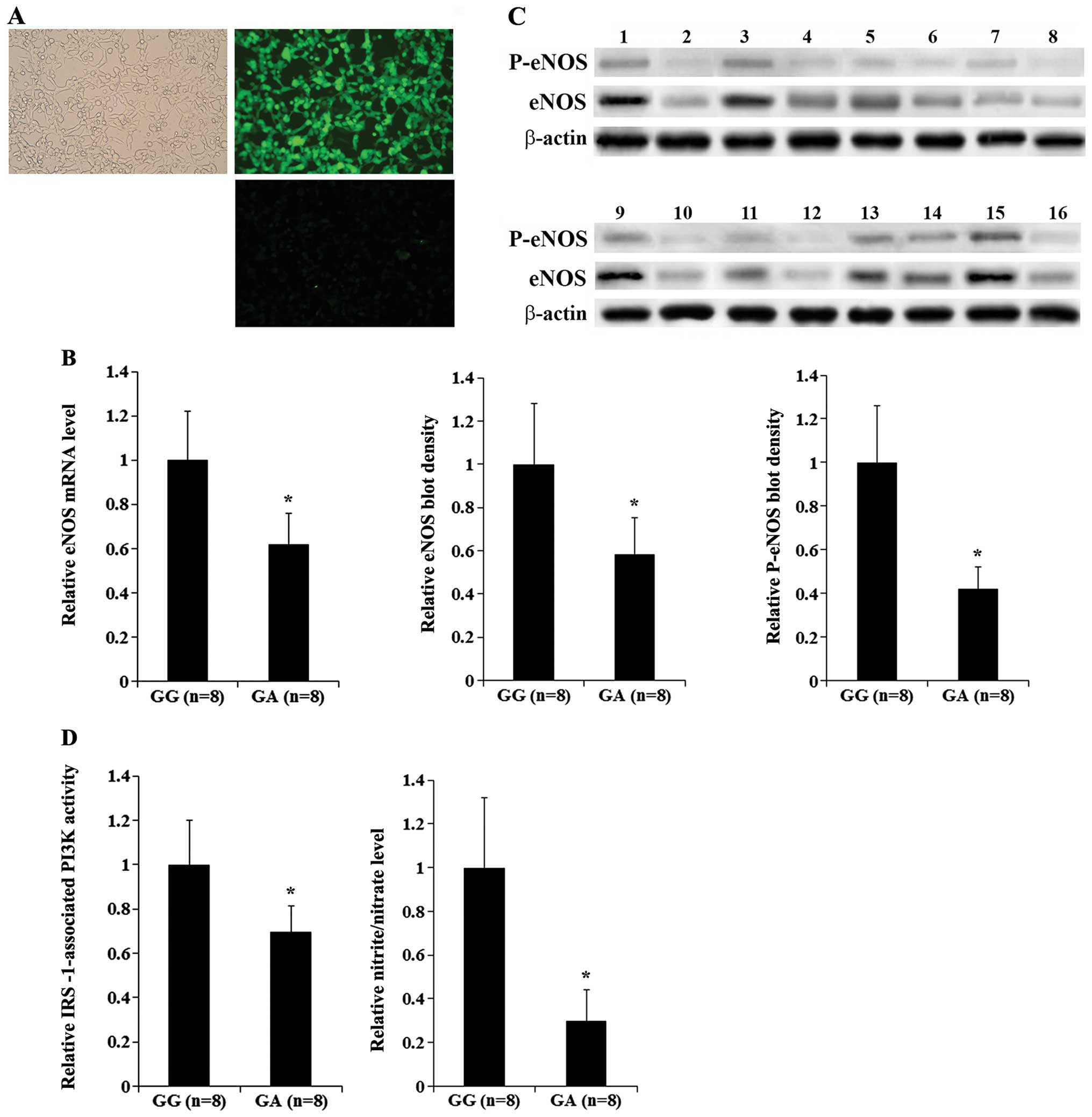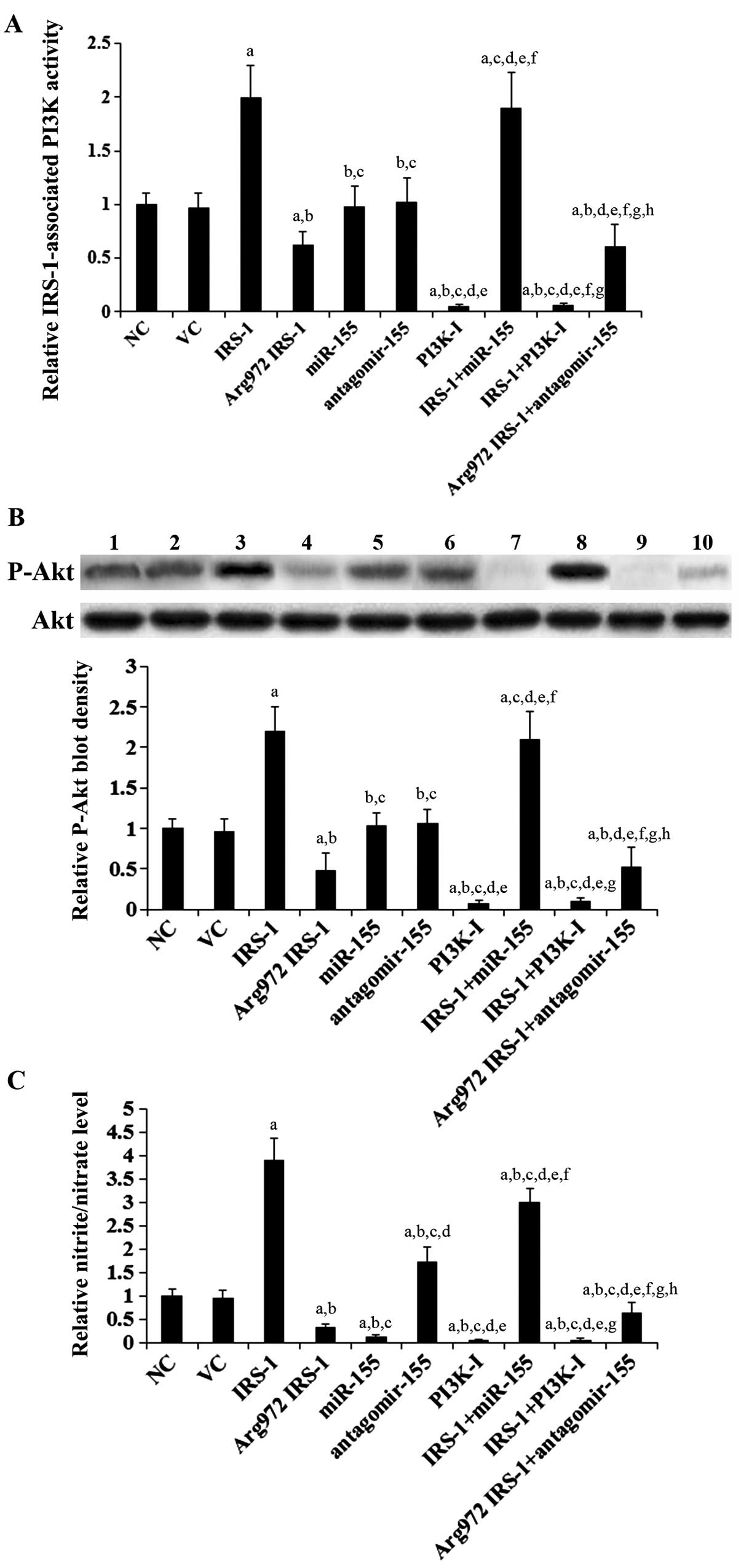|
1
|
Schulz R, Rassaf T, Massion PB, Kelm M and
Balligand JL: Recent advances in the understanding of the role of
nitric oxide in cardiovascular homeostasis. Pharmacol Ther.
108:225–256. 2005. View Article : Google Scholar : PubMed/NCBI
|
|
2
|
Balligand JL, Feron O and Dessy C: eNOS
activation by physical forces: from short-term regulation of
contraction to chronic remodeling of cardiovascular tissues.
Physiol Rev. 89:481–534. 2009. View Article : Google Scholar : PubMed/NCBI
|
|
3
|
Förstermann U and Münzel T: Endothelial
nitric oxide synthase in vascular disease: from marvel to menace.
Circulation. 113:1708–1714. 2006. View Article : Google Scholar : PubMed/NCBI
|
|
4
|
Searles CD: Transcriptional and
posttranscriptional regulation of endothelial nitric oxide synthase
expression. Am J Physiol Cell Physiol. 291:C803–C816. 2006.
View Article : Google Scholar : PubMed/NCBI
|
|
5
|
Alonso J, Sánchez de Miguel L, Montón M,
Casado S and López-Farré A: Endothelial cytosolic proteins bind to
the 3′ untranslated region of endothelial nitric oxide synthase
mRNA: regulation by tumor necrosis factor alpha. Mol Cell Biol.
17:5719–5726. 1997.PubMed/NCBI
|
|
6
|
Lai PF, Mohamed F, Monge JC and Stewart
DJ: Downregulation of eNOS mRNA expression by TNFalpha:
identification and functional characterization of RNA-protein
interactions in the 3′ UTR. Cardiovasc Res. 59:160–168. 2003.
View Article : Google Scholar : PubMed/NCBI
|
|
7
|
Laufs U and Liao JK: Post-transcriptional
regulation of endothelial nitric oxide synthase mRNA stability by
Rho GTPase. J Biol Chem. 273:24266–24271. 1998. View Article : Google Scholar : PubMed/NCBI
|
|
8
|
Yan G, You B, Chen SP, Liao JK and Sun J:
Tumor necrosis factor-alpha downregulates endothelial nitric oxide
synthase mRNA stability via translation elongation factor 1-alpha
1. Circ Res. 103:591–597. 2008. View Article : Google Scholar : PubMed/NCBI
|
|
9
|
Alberti KG and Zimmet PZ: Definition,
diagnosis and classification of diabetes mellitus and its
complications. Diabet Med. 15:539–553. 1998. View Article : Google Scholar : PubMed/NCBI
|
|
10
|
Huang PL: eNOS, metabolic syndrome and
cardiovascular disease. Trends Endocrinol Metab. 20:295–302. 2009.
View Article : Google Scholar : PubMed/NCBI
|
|
11
|
Huang PL: A comprehensive definition for
metabolic syndrome. Dis Models Mech. 2:231–237. 2009. View Article : Google Scholar
|
|
12
|
Hink U, Li H, Mollnau H, Oelze M, Matheis
E, Hartmann M, Skatchkov M, Thaiss F, Stahl RA, Warnholtz A, et al:
Mechanisms underlying endothelial dysfunction in diabetes mellitus.
Circ Res. 88:E14–E22. 2001. View Article : Google Scholar : PubMed/NCBI
|
|
13
|
Steinberg HO, Brechtel G, Johnson A,
Fineberg N and Baron AD: Insulin-mediated skeletal muscle
vasodilation is nitric oxide dependent. A novel action of insulin
to increase nitric oxide release. J Clin Invest. 94:1172–1179.
1994. View Article : Google Scholar : PubMed/NCBI
|
|
14
|
Scherrer U, Randin D, Vollenweider P,
Vollenweider L and Nicod P: Nitric oxide release accounts for
insulin’s vascular effects in humans. J Clin Invest. 94:2511–2515.
1994. View Article : Google Scholar : PubMed/NCBI
|
|
15
|
Montagnani M, Chen H, Barr VA and Quon MJ:
Insulin-stimulated activation of eNOS is independent of
Ca2+ but requires phosphorylation by Akt at
Ser1179. J Biol Chem. 276:30392–30398. 2001. View Article : Google Scholar : PubMed/NCBI
|
|
16
|
Zeng G, Nystrom FH, Ravichandran LV, Cong
L, Kirby M, Mostowski H and Quon MJ: Roles for insulin receptor,
PI3-kinase, and Akt in insulin-signaling pathways related to
production of nitric oxide in human vascular endothelial cells.
Circulation. 101:1539–1545. 2000. View Article : Google Scholar : PubMed/NCBI
|
|
17
|
Montagnani M and Quon MJ: Insulin action
in vascular endothelium: potential mechanisms linking insulin
resistance with hypertension. Diabetes Obes Metab. 2:285–292. 2000.
View Article : Google Scholar
|
|
18
|
Fallucca F, Dalfrà MG, Sciullo E, Masin M,
Buongiorno AM, Napoli A, Fedele D and Lapolla A: Polymorphisms of
insulin receptor substrate 1 and beta3-adrenergic receptor genes in
gestational diabetes and normal pregnancy. Metabolism.
55:1451–1456. 2006. View Article : Google Scholar : PubMed/NCBI
|
|
19
|
Hribal ML, Federici M, Porzio O, Lauro D,
Borboni P, Accili D, Lauro R and Sesti G: The Gly→Arg972
amino acid polymorphism in insulin receptor substrate-1 affects
glucose metabolism in skeletal muscle cells. J Clin Endocrinol
Metab. 85:2004–2013. 2000.PubMed/NCBI
|
|
20
|
Porzio O, Federici M, Hribal ML, Lauro D,
Accili D, Lauro R, Borboni P and Sesti G: The
Gly972>Arg amino acid polymorphism in IRS-1 impairs
insulin secretion in pancreatic beta cells. J Clin Invest.
104:357–364. 1999. View Article : Google Scholar : PubMed/NCBI
|
|
21
|
Huang C, Lin Z, Zhou Y, Fang M, Sun S,
Jiang W, Dong H, Lv B, Lan H, Chen M, et al: Arg972
insulin receptor substrate-1 is associated with elevated plasma
endothelin-1 level in hypertensives. J Hypertens. 30:1751–1757.
2012. View Article : Google Scholar : PubMed/NCBI
|
|
22
|
Federici M, Pandolfi A, De Filippis EA,
Pellegrini G, Menghini R, Lauro D, Cardellini M, Romano M, Sesti G,
Lauro R, et al: G972R IRS-1 variant impairs insulin regulation of
endothelial nitric oxide synthase in cultured human endothelial
cells. Circulation. 109:399–405. 2004. View Article : Google Scholar : PubMed/NCBI
|
|
23
|
Liu W, Zhou X, Yu F, Hu J and Hu W:
Arg972 Insulin receptor substrate-1 is associated with
decreased serum angiotensin-converting enzyme 2 levels in acute
myocardial infarction patients: in vivo and in vitro evidence.
Cardiovasc Diabetol. 12:1512013. View Article : Google Scholar
|
|
24
|
Nagoshi T, Matsui T, Aoyama T, Leri A,
Anversa P, Li L, Ogawa W, del Monte F, Gwathmey JK, Grazette L, et
al: PI3K rescues the detrimental effects of chronic Akt activation
in the heart during ischemia/reperfusion injury. J Clin Invest.
115:2128–2138. 2005. View Article : Google Scholar : PubMed/NCBI
|
|
25
|
Matsui T, Li L, del Monte F, Fukui Y,
Franke TF, Hajjar RJ and Rosenzweig A: Adenoviral gene transfer of
activated phosphatidylinositol 3′-kinaseand Akt inhibits apoptosis
of hypoxic cardiomyocytes in vitro. Circulation. 100:373–2379.
1999. View Article : Google Scholar
|
|
26
|
Polit DF and Sherman RE: Statistical power
in nursing research. Nurs Res. 39:365–369. 1990. View Article : Google Scholar : PubMed/NCBI
|
|
27
|
Sun HX, Zeng DY, Li RT, Pang RP, Yang H,
Hu YL, Zhang Q, Jiang Y, Huang LY, Tang YB, et al: Essential role
of microRNA-155 in regulating endothelium-dependent vasorelaxation
by targeting endothelial nitric oxide synthase. Hypertension.
60:1407–1414. 2012. View Article : Google Scholar : PubMed/NCBI
|
|
28
|
Chamorro-Jorganes A, Araldi E and Suarez
Y: MicroRNAs as pharmacological targets in endothelial cell
function and dysfunction. Pharmacol Res. 75:15–27. 2013. View Article : Google Scholar : PubMed/NCBI
|
|
29
|
Chen L, Monti S, Juszczynski P, Ouyang J,
Chapuy B, Neuberg D, Doench JG, Bogusz AM, Habermann TM, Dogan A,
et al: SYK inhibition modulates distinct PI3K/Akt-dependent
survival pathways and cholesterol biosynthesis in diffuse large B
cell lymphomas. Cancer Cell. 23:826–838. 2013. View Article : Google Scholar : PubMed/NCBI
|
|
30
|
Lusis AJ: Atherosclerosis. Nature.
407:233–241. 2000. View Article : Google Scholar : PubMed/NCBI
|
|
31
|
Calles-Escandon J and Cipolla M: Diabetes
and endothelial dysfunction: a clinical perspective. Endocr Rev.
22:36–52. 2001. View Article : Google Scholar : PubMed/NCBI
|














